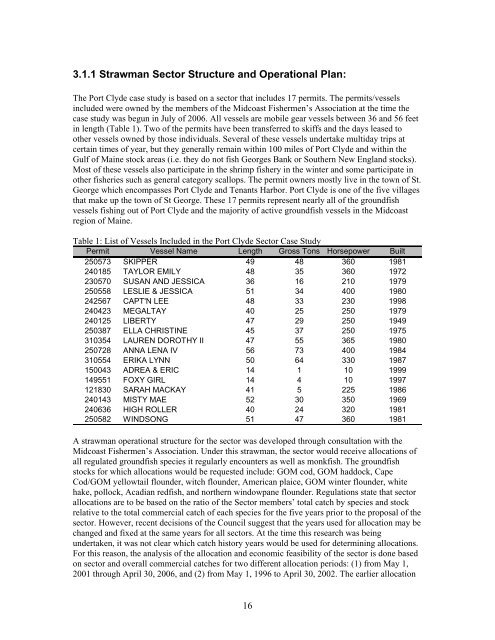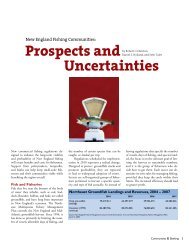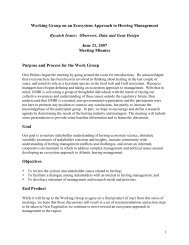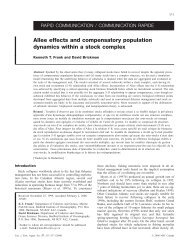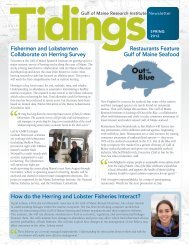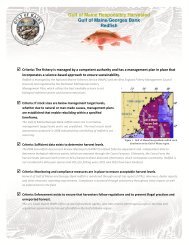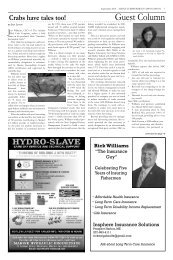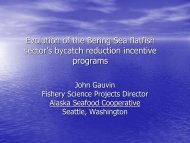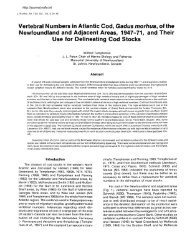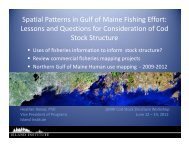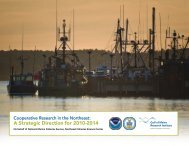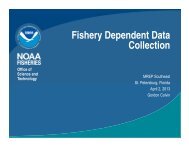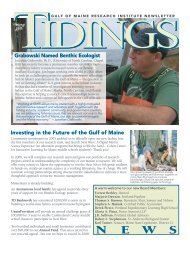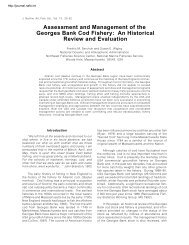Community-based Sectors for the New England Groundfish Fishery
Community-based Sectors for the New England Groundfish Fishery
Community-based Sectors for the New England Groundfish Fishery
You also want an ePaper? Increase the reach of your titles
YUMPU automatically turns print PDFs into web optimized ePapers that Google loves.
3.1.1 Strawman Sector Structure and Operational Plan:<br />
The Port Clyde case study is <strong>based</strong> on a sector that includes 17 permits. The permits/vessels<br />
included were owned by <strong>the</strong> members of <strong>the</strong> Midcoast Fishermen’s Association at <strong>the</strong> time <strong>the</strong><br />
case study was begun in July of 2006. All vessels are mobile gear vessels between 36 and 56 feet<br />
in length (Table 1). Two of <strong>the</strong> permits have been transferred to skiffs and <strong>the</strong> days leased to<br />
o<strong>the</strong>r vessels owned by those individuals. Several of <strong>the</strong>se vessels undertake multiday trips at<br />
certain times of year, but <strong>the</strong>y generally remain within 100 miles of Port Clyde and within <strong>the</strong><br />
Gulf of Maine stock areas (i.e. <strong>the</strong>y do not fish Georges Bank or Sou<strong>the</strong>rn <strong>New</strong> <strong>England</strong> stocks).<br />
Most of <strong>the</strong>se vessels also participate in <strong>the</strong> shrimp fishery in <strong>the</strong> winter and some participate in<br />
o<strong>the</strong>r fisheries such as general category scallops. The permit owners mostly live in <strong>the</strong> town of St.<br />
George which encompasses Port Clyde and Tenants Harbor. Port Clyde is one of <strong>the</strong> five villages<br />
that make up <strong>the</strong> town of St George. These 17 permits represent nearly all of <strong>the</strong> groundfish<br />
vessels fishing out of Port Clyde and <strong>the</strong> majority of active groundfish vessels in <strong>the</strong> Midcoast<br />
region of Maine.<br />
Table 1: List of Vessels Included in <strong>the</strong> Port Clyde Sector Case Study<br />
Permit Vessel Name Length Gross Tons Horsepower Built<br />
250573 SKIPPER 49 48 360 1981<br />
240185 TAYLOR EMILY 48 35 360 1972<br />
230570 SUSAN AND JESSICA 36 16 210 1979<br />
250558 LESLIE & JESSICA 51 34 400 1980<br />
242567 CAPT'N LEE 48 33 230 1998<br />
240423 MEGALTAY 40 25 250 1979<br />
240125 LIBERTY 47 29 250 1949<br />
250387 ELLA CHRISTINE 45 37 250 1975<br />
310354 LAUREN DOROTHY II 47 55 365 1980<br />
250728 ANNA LENA IV 56 73 400 1984<br />
310554 ERIKA LYNN 50 64 330 1987<br />
150043 ADREA & ERIC 14 1 10 1999<br />
149551 FOXY GIRL 14 4 10 1997<br />
121830 SARAH MACKAY 41 5 225 1986<br />
240143 MISTY MAE 52 30 350 1969<br />
240636 HIGH ROLLER 40 24 320 1981<br />
250582 WINDSONG 51 47 360 1981<br />
A strawman operational structure <strong>for</strong> <strong>the</strong> sector was developed through consultation with <strong>the</strong><br />
Midcoast Fishermen’s Association. Under this strawman, <strong>the</strong> sector would receive allocations of<br />
all regulated groundfish species it regularly encounters as well as monkfish. The groundfish<br />
stocks <strong>for</strong> which allocations would be requested include: GOM cod, GOM haddock, Cape<br />
Cod/GOM yellowtail flounder, witch flounder, American plaice, GOM winter flounder, white<br />
hake, pollock, Acadian redfish, and nor<strong>the</strong>rn windowpane flounder. Regulations state that sector<br />
allocations are to be <strong>based</strong> on <strong>the</strong> ratio of <strong>the</strong> Sector members’ total catch by species and stock<br />
relative to <strong>the</strong> total commercial catch of each species <strong>for</strong> <strong>the</strong> five years prior to <strong>the</strong> proposal of <strong>the</strong><br />
sector. However, recent decisions of <strong>the</strong> Council suggest that <strong>the</strong> years used <strong>for</strong> allocation may be<br />
changed and fixed at <strong>the</strong> same years <strong>for</strong> all sectors. At <strong>the</strong> time this research was being<br />
undertaken, it was not clear which catch history years would be used <strong>for</strong> determining allocations.<br />
For this reason, <strong>the</strong> analysis of <strong>the</strong> allocation and economic feasibility of <strong>the</strong> sector is done <strong>based</strong><br />
on sector and overall commercial catches <strong>for</strong> two different allocation periods: (1) from May 1,<br />
2001 through April 30, 2006, and (2) from May 1, 1996 to April 30, 2002. The earlier allocation<br />
16


